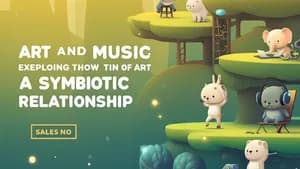Beyond the tangible, art and music share a deep connection to the human experience. They are not merely forms of entertainment but profound channels of communication that express our deepest emotions, connect us to our shared humanity, and provide solace, inspiration, and a sense of belonging. This article explores how both disciplines can enrich your life, highlighting the universal language that transcends cultures and time.
The Power of Expression: Art as a Mirror to the Soul
Art, in all its forms, from painting and sculpture to photography and film, offers a powerful means of self-expression. It allows you to explore your inner world, giving voice to your thoughts, feelings, and experiences. Whether you're sketching a landscape that captures your sense of wonder, painting a vibrant abstract piece that reflects your emotions, or sculpting a clay figure that embodies your dreams, art enables you to communicate in a language that transcends words.
Think about a time when you felt overwhelmed by a strong emotion. Perhaps you felt deeply saddened by a loss or exhilarated by a triumph. Did you ever find yourself seeking solace in art? Maybe you listened to a song that resonated with your feelings, or watched a film that mirrored your own journey. Art has this remarkable ability to provide a shared emotional vocabulary that allows us to connect with others who may be experiencing similar emotions.
Music: A Symphony of Emotion
Music, like art, has the power to evoke a wide spectrum of emotions. From the soaring heights of joy to the depths of despair, music can transport us to different emotional landscapes, allowing us to experience a range of feelings in a safe and transformative way. It's no wonder that music is often used in therapy and healing practices, as it can have a profound impact on our mental and emotional well-being.
Consider how music can affect you during different moments in your day. Do you listen to upbeat music to motivate yourself while studying, or soft melodies to help you relax before bedtime? Perhaps you find comfort in listening to your favorite songs when you're feeling down. Just as a musician carefully chooses notes and harmonies to create a compelling melody, you can intentionally select music that resonates with your mood and emotions, allowing it to uplift, soothe, or inspire you.
The Unifying Power of Art and Music
Art and music are not bound by geographical boundaries, cultural differences, or language barriers. They speak a language that transcends these limitations, connecting people across the globe through a shared experience of beauty, emotion, and meaning. When you look at a painting from a different culture, you may not understand the specific details or symbolism, but you can still feel its emotional impact. Similarly, a piece of music from a different tradition can still evoke a powerful emotional response within you.
This universal language of art and music fosters understanding and empathy, helping us to connect with individuals and communities that are different from our own. It allows us to see the world through different perspectives, to appreciate the diversity of human experiences, and to build bridges across cultural divides. Think of how iconic songs and works of art have transcended geographical boundaries and become beloved by people around the world. This demonstrates the power of art and music to unite us.
Art and Music: A Pathway to Learning
Art and music can enhance your learning in multiple ways, making education a more engaging and enriching experience. By tapping into your creativity and imagination, they can help you to understand complex concepts, remember information more effectively, and develop essential skills such as critical thinking, problem-solving, and communication.
For example, imagine you're learning about a historical event. Instead of simply reading about it in a textbook, you could create a painting that captures the essence of that event, or write a song that reflects the emotions of the people involved. This creative approach allows you to immerse yourself in the subject matter, connect with it on a deeper level, and retain the information more effectively. Think about how you might use visual aids, such as diagrams or sketches, to illustrate complex scientific concepts or to create a timeline for a historical period. Or consider composing a short song or poem to help you remember key dates or formulas. Art and music can serve as powerful tools to engage your imagination and enhance your learning experience.
Conclusion: Embracing the Universal Language
Art and music are not just hobbies or forms of entertainment; they are powerful tools that can enrich your life in countless ways. They allow you to express yourself authentically, to connect with others on a deeper level, and to explore the world with a greater sense of wonder and understanding. Whether you're actively creating art, listening to music, or simply appreciating the beauty around you, these disciplines can help you to live a more fulfilling and meaningful life. Embrace the universal language of art and music and unlock the vast potential that lies within them. You might be surprised at what you discover within yourself and the world around you.

